.

United States National Museum Bulletin 250
Contributions from
The Museum of History and Technology
Paper 62, pages 109-120
WHITE HOUSE CHINA OF THE LINCOLN ADMINISTRATION
in the Museum Of History And Technology
Margaret Brown Klapthor
Smithsonian Press
Washington, D.C.
1967
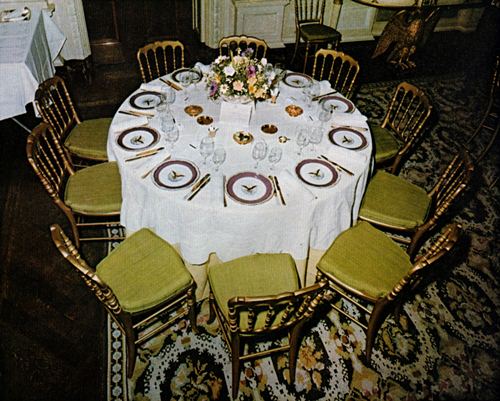
WHITE HOUSE COLLECTION
Figure 1: A table setting showing the Lincoln china being used for a luncheon
during the administration of President Lyndon B. Johnson.
Margaret Brown Klapthor
WHITE HOUSE CHINA
OF THE
LINCOLN ADMINISTRATION
In the Museum of History and Technology
This article on the china of the administration of President Abraham Lincoln is intended to be the first of a series of articles on Presidential china based on the collection in the Smithsonian Institution. From contemporary records in National Archives, newspaper articles and family records it is our hope to assemble material which will ultimately present the story of White House and Presidential china of every administration. Myths and facts surrounding this interesting topic will be examined and presented to assist the many collectors of this porcelain as well as others who admire and appreciate its historical interest.
In this first article, the author describes the efforts of Mrs. Abraham Lincoln to acquire porcelain suitable for official entertaining in the White House.
The Author: Margaret Brown Klapthor is associate curator of political history in the Smithsonian Institution’s Museum of History and Technology.
When Mrs. Lincoln arrived at the White House in 1861 she found the pantry sadly deficient in elegant tableware to set a State dinner. The last official State service had been purchased by the White House during the administration of President Franklin Pierce (it is the china known popularly as the “red edge” set), and not enough of that was left to serve a large dinner party.
Theodore R. Davis, who designed the State china purchased during the administration of President Rutherford B. Hayes, wrote an article, published in the May 1899 issue of the Ladies’ Home Journal, on the “Presidential Porcelain of a Century.” He records that in 1860 he saw the State Dining Room of the White House set up for the formal dinner given [Pg 112]for the visiting Prince of Wales, and that “the dishes were more or less odd, but generally comprised what was known as the ‘red edge set’.”
Chinaware was not the only thing needed in the Executive Mansion in the opinion of Mary Todd Lincoln. Fortunately for her, Congress was accustomed to appropriating $20,000 to refurnish the President’s House to the taste of each new First Lady. This money became available to her when the special session was convened in April 1861, and Mrs. Lincoln set out the next month on a shopping trip to New York and Philadelphia. She was accompanied by a favorite cousin, Mrs. Elizabeth Todd Grimsley, who had come to Washington for the inauguration in March and stayed on at the White House with the Lincolns for six months.
The ladies’ arrival in New York City on May 12, was duly noted in the city newspaper. On May 16, 1861, The New York Daily Tribune records under the heading Personal:
Mrs. Lincoln employed the greater portion of Wednesday forenoon in making purchases. Among other places she visited the establishments of Lord & Taylor, and Messrs. E. V. Haughwout and Co. At the latter establishment she ordered a splendid dinner service for the White House in “Solferino” and gold with the arms of the United States emblazoned on each piece. The purchases also include some handsome vases and mantle ornaments for the blue and green rooms.
The firm of E. V. Haughwout and Co. whose bill head identifies it as “Importers and Decorators of French China” was accustomed to Executive Mansion patronage. Under the name of Haughwout and Dailey they had sold a dinner service to President Pierce in 1853.[1] During Mrs. Lincoln’s May visit, Haughwout’s must have shown her a handsome specimen plate they had exhibited at the Crystal Palace Exhibition in New York in 1853 which had been made for President Pierce’s approval. A picture of the plate in the Haughwout and Dailey display is shown in the catalog of the Exhibition where it is identified as “a specimen plate of a dinner service manufactured for the President of the United States with the American eagle and blue band in Alhambra style.”[2] President Pierce evidently did not like the design as the service he subsequently purchased from Haughwout and Dailey had a plain red band and was not the one manufactured for his approval and exhibited in New York.
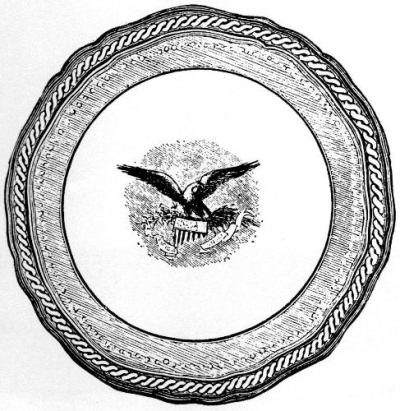
Figure 2.—Plate illustrated in the catalog of the Crystal Palace Exhibition, 1853. (Smithsonian photo 60016.)
Mary Todd Lincoln was delighted with the plate displayed at the Crystal Palace Exhibition and ordered a complete dinner service of that design. Her only change was to have a wide “Solferino” border painted on the service instead of the blue border specified for the 1853 plate. This bright purplish-red color had become extremely fashionable since its discovery in 1859, and it provided another variation of Mrs. Lincoln’s favorite color, which she indulged in personal attire as well as in room decor.
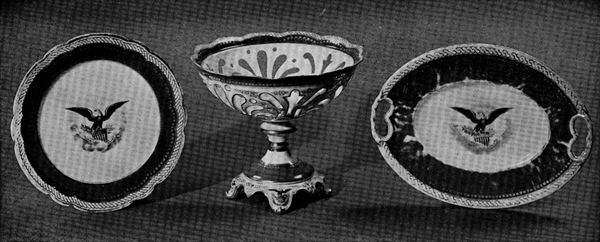
Figure 3.—Plate, compote, and small platter from the purple-bordered State china used during the administration of President Abraham Lincoln, (USNM ace. 221233; Smithsonian photo 48115-A.)
Mrs. Lincoln probably first saw and gave her approval to the elegant new china when she returned to New York for more shopping in August. The china was delivered on September 2, 1861, with a bill itemized as follows:[3]
One fine Porcelain Dining Service of One Hundred, and ninety pieces ... 190 ... decorated Royal purple, and double gilt, with the Arms of the United States, on each piece, for the Presidential Mansion ... namely ...
| Two Bowls for Salad |
| Four Shells do Pickles |
| Four Meat Platters 9 inch |
| Four do do 10 do |
| Four do do 13 do |
| Two do do 15 do |
| Two do do 18 do |
| Two do do 20 do |
| Four Fish do various sizes, and forms |
| Two Butter Dishes, with drainers, and covers. |
| Six uncovered vegetable dishes or bakers. |
| Ninety-six Dinner Plates 9 inch |
| Forty-eight Soup do 9 do |
| Four Large Water Pitchers. |
| Two Bowls for Ice. |
| Eleven Hundred, and ninety-five dollars. |
One fine Porcelain Dessert Service, consisting of Two hundred and eight pieces ... 208 ... richly decorated to match Dining Set ... namely.
| Two Stands for Custard Cups |
| Thirty-six do do |
| Eight High Comportiers for fruit. |
| Two do do large do do |
| Four shell do |
| Two Bowls for Strawberries |
| Two Dessert Sugars |
| Six Round High Baskets for fruit. |
| Two Oval do do do do |
| Sixty Dessert Plates 8 inch |
| Thirty-six after Dinner Coffees. |
| Eight Hundred, and thirty-seven dollars. |
One fine Breakfast, and Tea Service, containing Two Hundred, and sixty pieces, richly decorated to match Dinner Service ... namely.
| Forty-eight Tea Plates 6½ inch |
| Thirty-six Preserve do 4½ do |
| Thirty-six Coffees for Breakfast |
| Twenty-four Egg Cups |
| Thirty-six Teas |
| Eight Plates for Cake |
| Seven Hundred, and fifty nine dollars. |
Four Small Sevres Centre Pieces for Bon Bons, decorated to match Dinner Service @ Twenty-five = One Hundred Two Large Centre Pieces, Sevres, supported by “White Pelicans and decorated to match dinner service
| @ One Hundred = Two Hundred |
| Two Punch Bowls, decorated to match dinner service |
| @ Fifty = One Hundred |
| Packages Four Dollars |
| Total Amount |
| Three Thousand, one Hundred and Ninety-five dollars. |
The picture of the design presented for President Pierce’s inspection in 1853 which appears in the catalog of the New York Crystal Palace Exhibition[4] is proof of the readiness with which symbolism is read into a design which came into existence long[Pg 114] before the symbol is appropriate. Writing in 1895 Edwin Atlee Barber says of the Lincoln China that the design for the decoration, selected after much consultation among officials at Washington, was added in New York by the importer. It consisted of a spirited rendering of the arms of the United States—the American eagle mounted on the national shield and beneath it the motto E Pluribus Unum. This design was engraved and then transferred to the china as an outline to be filled in with color. The border of the plate, a gold guilloche, or cable, of two strands entwined and, thus, mutually strengthening each other, was intended to signify the union of the North and South.[5] The same idea was meant to be conveyed in the central design: “Though clouds surround our Country, the sunlight is breaking through.” The explanation of the symbolism of the design, while appropriate for the Lincoln Administration, could hardly have been true for the china which was originally designed for Presidential use in 1853.
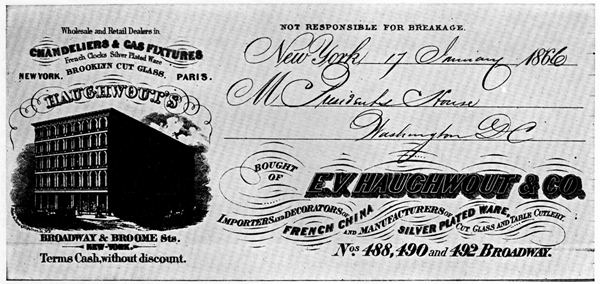
Figure 4.—Letterhead of E. V. Haughwout & Co., from whom the purple set was ordered. (Smithsonian photo 60001-A.)
Tradition identifies the blanks on which the design of the Lincoln china was painted as being imported from the Haviland factory in Limoges, France. The original china bears no maker’s mark, however, as this was more than ten years before the Haviland factory started to mark their ware.[6] The earliest positive link of the Lincoln china to Haviland and Company seems to be an affidavit which Theodore R. Davis attached to a Lincoln plate in 1881 saying “This plate One of the Lincoln Set made by Haviland & Co. was used by President Garfield when upon his death bed. The plate was broken in bringing it from the President’s room and was given by Wm. Crump to Theo. R. Davis Sept. 1881.” The plate is now in the collections of the State Historical Society of Wisconsin. It is possible that Theodore Davis,[Pg 115] a personal friend of Theodore Haviland, had derived directly from Mr. Haviland this manufacturer identification of the china which Haughwout decorated.
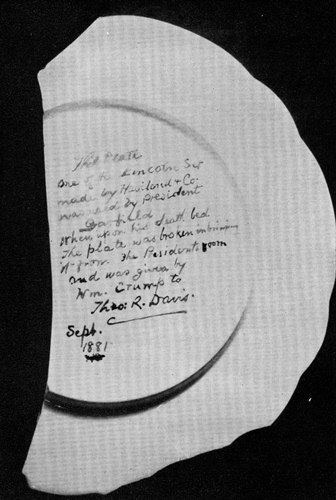
Figure 5.—Lincoln plate which bears affidavit of Theodore R. Davis. (Courtesy of the State Historical Society of Wisconsin.)
The official dinner service so delighted Mrs. Lincoln that she ordered a similar set for herself. On the personal service the initials “M. L.” were substituted for the arms of the United States as decoration. Mrs. Grimsley says “... this latter, I know, was not paid for by the district commissioner, as was most unkindly charged when it was stored away.”[7] It has been suggested that the personal china was paid for by a withdrawal of $1106.73 from the President’s account with the bank of Riggs and Co.
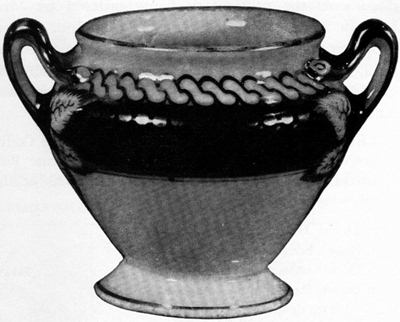
Figure 6.—Custard cup From the Purple-Bordered State China used during the administration of President Abraham Lincoln. (USNM acc. 206542; Smithsonian photo 44120-G.)
The personal china was an indiscreet purchase, at best, and Mrs. Lincoln was soon accused of buying the china out of public funds. In the midst of the campaign in which Lincoln ran for re-election in 1864 an opposition newspaper, The New York World, published a bitter attack on the President and his wife charging that the bill submitted by Haughwout for the State service had been padded to include the cost of the personal china.[8] According to the paper’s editorial, the deceit was discovered when the amount of the bill was questioned by a clerk in the Treasury Department and “Honest Abe,” when cornered, made payment out of his own pocket. This story seems to be refuted by the evidence on the Haughwout bill, which was signed by the Comptroller for payment on September 16, 1861, within two weeks after the china was received, and only three after President Lincoln had approved the bill.
The extent to which this controversy spoiled Mrs. Lincoln’s pleasure in the handsome purple service perhaps can be measured by the fact that after President Lincoln was re-elected, she purchased another large china service for the White House. A bill, recently discovered at the National Archives,[Pg 116] documents the new set as being ordered by Mrs. Lincoln from J. K. Kerr of 529 Chestnut Street, Philadelphia, whose establishment, known as China Hall, specialized in French and English china and glassware. Dated January 30, 1865, the bill was for:[9]
1 Extra Large French China, Dining, Dessert and Coffee Service, decorated on a White ground, delicate Buff Border with burnished Gold lines consisting of the following pieces.
| 12 | Dozen Dining plates | ||
| 6 | Dozen Soup plates | ||
| 6 | Dozen Dessert plates | ||
| 6 | Dozen Ice Cream, or peaches & cream plates deep | ||
| 1 | Large dish for head of table | ||
| 1 | Foot dish | ||
| 2 | Second course head & foot dishes | ||
| 2 | more dishes | ||
| 2 | more dishes | ||
| 2 | more dishes | ||
| 4 | vegetable dishes with covers | ||
| 4 | more vegetable dishes with covers | ||
| 4 | Sauce tureens | ||
| 4 | Sauce Boats | ||
| 4 | Stands for Sauce Boats | ||
| 4 | Pickle Shells | ||
| 2 | Salad Bowls | ||
| 2 | Custard Stands | ||
| 48 | Custard Cups with covers | ||
| 2 | Large rich oval fruit Baskets | ||
| 4 | Smaller round do | ||
| 4 | Fruit Comports Shell form for fruit | ||
| 4 | do do high round | ||
| 2 | Dessert Sugar bowls with covers | ||
| 48 | After Dinner Coffee Cups & Saucers | ||
| 1 | Large Dish for Fish | $1700 |
Records show that the china was brought to Washington by Harnden Express, as there is a voucher “For freight on 5 casks from Philadelphia, Pennsylvania to Washington, D.C., mkd Mrs. A. Lincoln $28.50. China from J. Kerr Phila. Pa. for dinner.” It is signed “J. K. Kerr” “Mrs. Lincoln” and is dated February 13, 1865.[10]
Two weeks later, on February 28, Kerr sent a bill for some additions to the service as follows:[11]
| 2 | Dozen Coffee Cups & Saucers | |||
| Delicate Buff Border & Gilt | 20.00 | 40.00 | ||
| 4 | Water pitchers do do | 10.00 | 40.00 | |
| 4 | do smaller do do | 8.00 | 32.00 | |
| 4 | do do do do | 6.00 | 24.00 | |
| 4 | do do do do | 5.00 | 20.00 | |
| 6 | bowls do do | 2.50 | 15.00 | |
| Package | 2.50 | |||
| 173.50 |
Two months later President Abraham Lincoln was assassinated. The china so recently ordered could hardly have been used by Mrs. Lincoln, and evidently payment had not been made, for it is recorded that at one of the first conferences which B. B. French, Commissioner of Public Buildings and Grounds, had with President Johnson in April 1865, he sought the President’s approval of payment for a purchase of china by Mrs. Lincoln.[12]
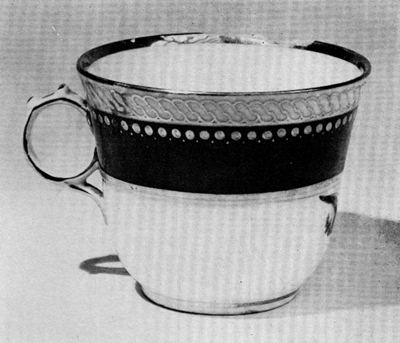
Figure 7:—Coffee cup From the Purple-Bordered State China used by President Abraham Lincoln at dinner at the White House on the night of his assassination. (USNM acc. 219098; Smithsonian photo 45088-D.)
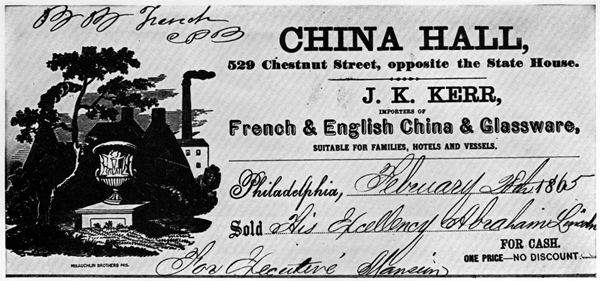
Figure 8.—Letterhead of J. K. Kerr, from whom the buff set was ordered. (Smithsonian photo 60001-B.)
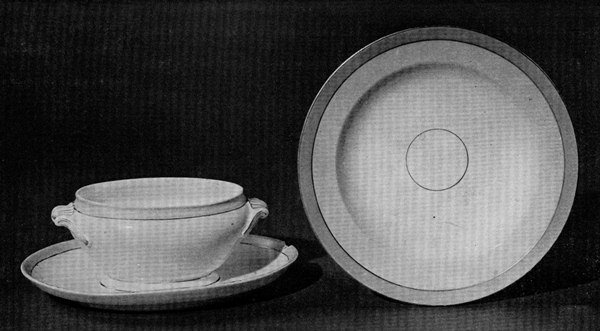
Figure 9.—Gravy boat and soup bowl from the buff-bordered French porcelain ordered by Mrs. Lincoln for the White House in 1865. (USNM acc. 228204; Smithsonian photo 48115-Y.)

Figure 10.—Pieces from the buff-bordered service displayed in the China Room in the White House. (Photo by Abbie Rowe, courtesy National Park Service.)
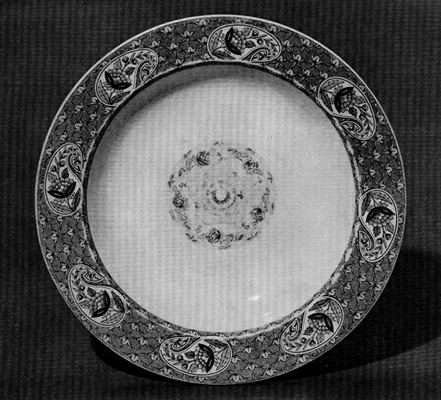
Figure 11.—Soup bowl from the Royal Worcester service used at the summer White House at the Soldiers’ Home during the administration of President Abraham Lincoln. (USNM acc. 228204; Smithsonian photo 48115-F.)
Despite Commissioner French’s concern, the account was not completely settled until a year after the china had been delivered. The first bill is receipted as paid[Pg 119] on August 29, 1865, at which time it was endorsed “Received from B B French C. P. Bgs the above amnt of Two thousand three hundred & thirty two dollars in full of this account.” (The difference between this amount and that given above is accounted for by the fact that the original order included 4 dozen goblets and 28 dozen wineglasses of various sizes, costing a total of $632.50.) The second bill was paid on February 10, 1866.
The inventory made when Mrs. Lincoln turned over the White House to President Johnson lists under china and glassware “One full set China,” which was certainly this buff and gold service, and “3 small remnants of china sets nearly all broken up,” which must have included the remaining pieces of the royal-purple service.[13]
Evidently, the Johnsons decided to use the purple china, because we find that in less than a year they ordered replacement pieces for it. A bill from E. V. Haughwout, dated January 17, 1866[14] lists—
To the following articles of rich China Ware with Arms & Crests of the U.S. to replace the pieces broken & lost of the Solferino sett viz
| 1 | salad dish, 4 pickles, 36 custard cups, | ||
| 24 | egg cups, 18 dishes—4/10-, 6/11-, 6/13-, 1/15-, 1/18-inch | ||
| 6 | comports 3/high, 2/low, & 1/shell | ||
| 2 | dessert sugars, 2 round baskets | ||
| 2 | butter dishes, 31 dinner plates | ||
| 57 | dessert plates, 48 tea plates | ||
| 25 | soup " , 26 preserve " | ||
| 36 | breakfast coffees, 36 black coffees | ||
| 36 | teas, 1 Cake plate, 4 pitchers | ||
| 1 | Ice bowl | 2061.25 |
Even with this second order, which almost equalled the original in size and cost, the purple set did not last; early in the administration of President Grant not enough of it was left to set the table in the State Dining Room satisfactorily. Those who handled the Lincoln set grew weary, it is said, of the constant breakage and became convinced that not careless handling but “bad luck in the china itself” was destroying both the dishes and the patience of those who were responsible for them.[15]
The story of the china associated with the Lincoln administration must also include a service used by the Lincolns at the summer White House which they maintained on the grounds of the Soldiers’ Home in Washington, D.C. Recently, the Quartermaster Corps of the Army turned over to the White House for the china collection some pieces of Royal Worcester china used in the house at the time of President Lincoln’s occupancy. It has a wide border of tiny gray and yellow flowers in a diaper design, with a multicolored floral wreath in the center of the plate. This use of English china and the informal design of the set is noteworthy, as almost every set of official china up to this time had been French, and French china continued to be used at the White House until almost the end of the 19th century.
It is appropriate in this discussion of the Lincoln china to mention the number of commemorative reproductions which were made for sale to the general public as souvenirs in the last quarter of the 19th century. The earliest of these reproduction pieces seem to be some which are marked on the back “Fabriqué par Haviland & Co./Pour/J. W. Boteler & Bro./Washington.” The firm of J. W. Boteler and Brother is first listed in the Washington City Directory in 1867 and it was in existence until 1881 when the name of the firm was changed to J. W. Boteler & Son. The dates of Boteler & Brother encompasses the period of the celebration of the Centennial of the United States in 1876. This celebration created intense interest in the Presidency and objects which symbolized the office, providing a ready market for copies of the Lincoln china. Indeed several different pieces of White House china have been brought to our attention with family legends that they were purchased at the “World’s Fair.” In each case it has been clear that the “Fair” meant the Centennial Exposition in Philadelphia in 1876. Two reproduction plates have been brought to the Smithsonian Institution for examination. On both of these the words “Administration/Abraham Lincoln” were stamped on the back in red. It is well for collectors[Pg 120] of White House china to remember that the original pieces of the Lincoln service did not bear any mark on the reverse.

Figure 12.—Drawing of the mark found, in red, on the two plates submitted to the Museum for identification.
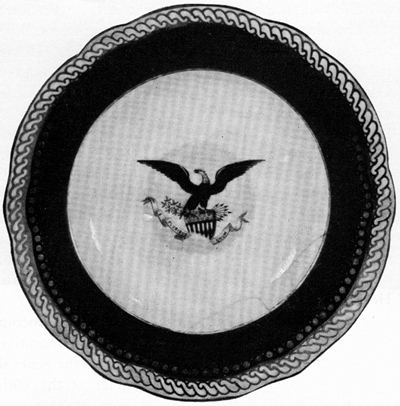
Figure 13.—Obverse of Lincoln plate bearing the mark of J. W. Boteler and Bro. (Smithsonian photo 44120.)
The excellent quality of the pieces bearing the Boteler mark may explain a persistent legend that Edward Lycett was associated with the Lincoln service.[16] Mr. Lycett came to this country from England in 1861 and thereafter was identified with the development and expansion of the art of china painting in America until the turn of the century. Many sources credit Mr. Lycett with painting the second order of the Lincoln service on commission of John Vogt & Co. of New York City. As the records establish the fact that the second order for the china was made to E. V. Haughwout & Co., just as was the first, we can only speculate that perhaps Mr. Lycett painted the commemorative china which bears the mark of J. W. Boteler & Brother and of Haviland & Co. which is so beautifully hand painted to match the official White House china.
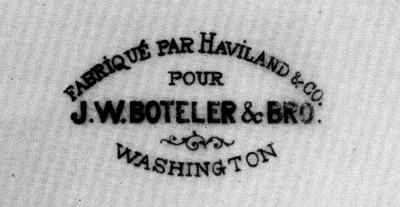
Figure 14.—Mark of J. W. Boteler & Bro. used on reverse of Lincoln plate. (Smithsonian photo 44120-L.)
In the collections of the Smithsonian’s Museum of History and Technology are the following pieces of the royal-purple set of Lincoln china:
Plate and 2-handled custard cup. Gift of Col. Theodore Barnes, (USNM accession 206542, cat. nos. 58566 and 58567).
Dinner coffee cup and saucer, gift of Mr. Lincoln Isham (USNM accession 219098, cat. no. 219098.9). This cup and saucer are the ones which were used by President Lincoln at dinner on the night of April 14, 1865, just before he attended the performance at Ford’s Theater at which he was assassinated.
The following pieces are in the Smithsonian Institution on loan from the White House (accessions 221233 and 228204).
From the purple set:
small oval platter
meat platter
3 compotes
oval fruit basket
coffee cup and saucer
water pitcher
fish platter
dinner plate
shallow bowl
soup bowl.
From the set with the buff band:
soup bowl
gravy boat.
U.S. Government Printing Office; 1967
For sale by Superintendent of Documents, U.S. Government Printing Office
Washington, D.C. 20402 Price 35 cents
Footnotes:
[1] National Archives, Record group 217, Government Accounting Office, miscellaneous Treasury accounts, receipted account 113810, voucher 4.
[2] Official catalog of the New York exhibition of the industry of all nations, 1853. New York, 1853.
[3] National Archives, record group 217, General Accounting Office, miscellaneous Treasury accounts, receipted account 141451.
[4] Loc. cit. (footnote 2).
[5] Edwin Atlee Barber, “The Pioneer of China Painting in America,” The Ceramic Monthly (September 1895), vol. 2, no. 2, pp. 15-20.
[6] Letter from Charles Haviland at Limoges, France, to Theodore Haviland in the United States dated March 4, 1869, in the archives of Haviland & Co., Inc.: “It would certainly be a good thing to stamp all our china with our name if: 1st our china was better than any one else or at least as good and 2nd if we made enough for our trade. Without that it would turn against us and learn people that by ordering through Vogt or Nittal they could get Gibus or Julieus china which is better than ours. And if ours was the best but we did not make enough to fill orders there would be a complaint when we gave other manufacturer’s china. So our first aim must be to manufacture as well or better than any body else and to make all we sell——Then & then only it will be a capital thing to stamp all our make with our name.” Their goal was finally achieved in 1876.
[7] Elizabeth Todd Grimsley, “Six Months in the White House,” Journal, Illinois State Historical Society, vol. 19, nos. 3-4, pp. 42-73.
[8] The New York World, September 26, 1864.
[9] National Archives, record group 217, General Accounting Office, miscellaneous Treasury accounts, receipted account 157178, voucher 9.
[10] Ibid., voucher 26.
[11] Ibid., voucher 25.
[12] George Fort Milton, The Age of Hate: Andrew Johnson and the Radicals (New York: Coward-McCann, Inc., 1930), p. 229.
[13] National Archives, records of Commissioner of Public Buildings and Grounds, inventory of the Lincoln Administration, 1865.
[14] Op. cit. (footnote 9), voucher 18.
[15] Theodore R. Davis, “Presidential Porcelain of a Century,” The Ladies’ Home Journal (May 1889), p. 4.
[16] Edwin Atlee Barber, loc. cit. (footnote 5).


